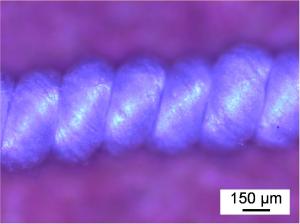
Researchers at the University of Texas at Dallas (UT Dallas) have created a material made from nanofibers that can stretch up to seven times its length and still remain tougher than Kevlar®.
These structures absorb up to 98 joules per gram, as opposed to Kevlar, often used to make bulletproof vests, which can absorb up to 80 joules per gram. The researchers hope the structures will one day form material that can reinforce itself at points of high stress and could potentially be used in military airplanes or other defense applications.

Piezoelectric action
In a study published by ACS Applied Materials and Interfaces, a journal of the American Chemical Society, researchers twisted nanofiber into yarns and coils. The electricity generated by stretching the twisted nanofiber formed an attraction ten times stronger than a hydrogen bond, which is considered one of the strongest forces formed between molecules.
Researchers sought to mimic their earlier work on the piezoelectric action (how pressure forms electric charges) of collagen fibers found inside bone in hopes of creating a high-performance materials that can reinforce itself, according to Dr. Majid Minary, assistant professor of mechanical engineering in the University’s Erik Jonsson School of Engineering and Computer Science and senior author of the study.
“We reproduced this process in nanofibers by manipulating the creation of electric charges to result in a lightweight, flexible, yet strong material,” saya Minary, who is also a member of the Alan G. MacDiarmid NanoTech Institute. “Our country needs such materials on a large scale for industrial and defense applications.”
For their experiment, researchers spun nanofibers out of PVDF and its co-polymer, polyvinvylidene fluoride trifluoroethylene (PVDF-TrFE), twisted the fibers into yarns, and then continued to twist the material into coils. Researchers measured mechanical properties of the yarn and coils, such as how far it can stretch and how much energy it can absorb before failure. The next step in the research is to make larger structures out of the yarns and coils, Minary says.

A Texas A&M University engineer also participated in the work, which was funded by the Air Force Office of Scientific Research Young Investigator Research Program and the National Science Foundation.
Photos: Mahmoud Baniasadi et al./ACS Applied Materials and Interfaces
 TEXTILES.ORG
TEXTILES.ORG


